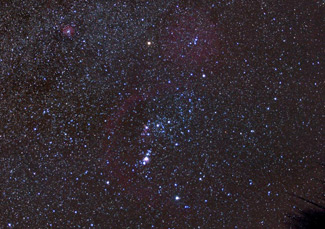 Recently, I stood in a foot of snow when the Fahrenheit temperature was barely in the teens. I dressed warmly (or so I thought), but I wasn’t doing anything physical, so the cold was biting at my extremities. Yes, I was observing.
Recently, I stood in a foot of snow when the Fahrenheit temperature was barely in the teens. I dressed warmly (or so I thought), but I wasn’t doing anything physical, so the cold was biting at my extremities. Yes, I was observing.
As much as I despise cold weather (see, for instance, my blog “The weather gods hate me”), there’s a lot to be said for observing during the winter. When the temperature dips well below freezing, the crunchy snow pack seems to absorb all the atmosphere’s moisture. Not only does this deter cloud formation (including fog), but also dry air doesn’t carry light pollution as well as moist air.
More often than not, winter nights mean no or low-velocity wind. Nothing kills atmospheric steadiness (seeing) like wind. And nothing kills an observer’s desire like the words “wind-chill factor.”
Winter offers the brightest stars of any season, terrific nebulae and star clusters, and a Milky Way not many observers know well. In the summer, the well-known Great Rift (a dark region that appears to split the Milky Way) passes through Cygnus, Aquila, and Scutum. And even far-northern observers are familiar with the southern summer Milky Way in Ophiuchus, Scorpius, and Sagittarius. After all, that region houses our galaxy’s center.
How many northern observers, on the other hand, know the southern winter Milky Way well? Traditionally, it starts to the left (east) of the familiar constellation Orion the Hunter in the not-so-well-known star group Monoceros the Unicorn. From there, head south through Canis Major the Great Dog and into Puppis the Stern.
This region is so rich in open clusters that you’ll run out of nights before you run out of star clusters to observe. Each has something special to offer (that’s right, they don’t all look the same), but pay particular attention to the Messier clusters M41, M46, M47, M50, and M93, and the spectacular magnitude 3.8 Tau Canis Majoris Cluster (NGC 2362).
If you’re a fan of nebulae, you’ll find both the Rosette Nebula (NGC 2237-9, 46) and the Cone Nebula (NGC 2264) in northern Monoceros. Through an 8-inch or larger telescope and a nebula filter, you can coax the nebulosity into view under a dark sky, and that may warm your feet for a while. Both of these immense gas clouds, however, also contain prominent open clusters.
Within the Rosette Nebula, NGC 2244 formed recently, and several of its stars provide the energy with which the nebula shines. In the Cone Nebula, the star group is the aptly named 4th-magnitude Christmas Tree Cluster. ’Tis the season, after all. Through binoculars, the “tree” appears 0.5° tall and triangular. 7x50 binoculars will reveal between two and three dozen stars. How many depends on how dark your sky is. The Christmas Tree Cluster’s brightest star is S Monocerotis, which, rather than topping the tree, forms its base.
As you can see, even the southern winter sky offers a lot more than just Orion — a whole lot more.
What’s that you say? It’s not winter yet? Oh, good grief!